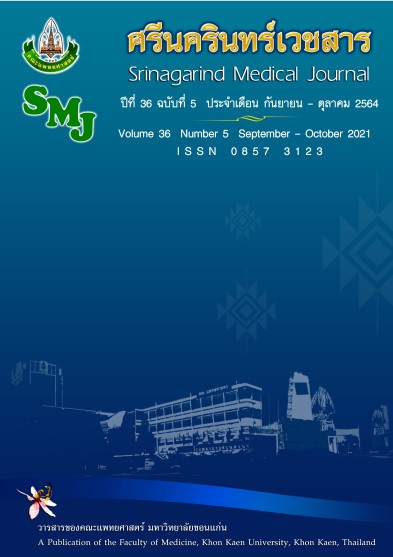การวินิจฉัยภาวะติดเชื้อรอบข้อเทียมในผู้ป่วยผ่าตัดเปลี่ยนข้อเทียมและแนวทางปฏิบัติเพื่อสืบค้นโรคติดเชื้อรอบข้อเทียมในโรงพยาบาลศรีนครินทร์
Abstract
Diagnosis in Periprosthetic Joint Infection and Clinical Practice Guideline for Periprosthetic Joint Infection in Srinagarind Hospital
Witchaporn Witayakom, Rit Apinyankul*, Kamolsak Sukhonthamarn
Department of Orthopaedics, Faculty of Medicine, Khon Kaen University
*Corresponding author: Rit Apinyankul, Department of Orthopaedics, Faculty of Medicine, Khon Kaen University. E-mail: ritap@kku.ac.th
บทคัดย่อ
การรักษาภาวะข้อเสื่อมระยะรุนแรงและภาวะกระดูกหักรอบข้อสะโพก ข้อเข่าด้วยการผ่าตัดเปลี่ยนข้อเทียมเป็นวิธีการรักษาที่ประสบความสำเร็จสูงและได้ผลลัพท์การผ่าตัดดีมาก อย่างไรก็ตาม การติดเชื้อภายหลังผ่าตัดเปลี่ยนข้อเทียมเป็นภาวะแทรกซ้อนที่พบได้ไม่บ่อย แต่มีความสำคัญอย่างสูง เนื่องจากส่งผลให้เกิดผลกระทบต่อการใช้งานและคุณภาพชีวิตของผู้ป่วย การวินิจฉัยภาวะติดเชื้อรอบข้อนับเป็นขั้นตอนแรกในการดูแลผู้ป่วยก่อนนำไปสู่การรักษา ในปัจจุบันผู้นิพนธ์พบปัญหาการสืบค้นโรคเพื่อนำไปสู่การวินิจฉัยไม่ครบถ้วน การแปลผลทางห้องปฏิบัติการที่ยังมีความเข้าใจคลาดเคลื่อน ทั้งในผู้ป่วยส่งต่อจากโรงพยาบาลต้นทางและผู้ป่วยที่ได้รับการผ่าตัดในโรงพยาบาลศรีนครินทร์ ซึ่งนำไปสู่การวินิจฉัยและรักษาที่ล่าช้า ส่งผลกระทบต่อผลลัพธ์การรักษา ระยะเวลาการรักษา และเพิ่มภาวะทุพพลภาพของผู้ป่วย ผู้นิพนธ์ได้รวบรวมความรู้ และแนวปฏิบัติเกี่ยวกับภาวะติดเชื้อรอบข้อเทียม ทั้งด้านปัจจัยเสี่ยง ประวัติ อาการและอาการแสดง เชื้อก่อโรคและเกณฑ์การวินิจฉัยที่มีการเผยแพร่ใหม่ รวมถึงแผนภาพแนวทางการสืบค้นโรคที่เป็นปัจจุบัน ทันสมัย และสะดวกต่อการวินิจฉัยภาวะติดเชื้อรอบข้อเทียมในโรงพยาบาลศรีนครินทร์
คำสำคัญ: ภาวะติดเชื้อรอบข้อเทียม; แนวทางปฏิบัติเพื่อสืบค้น; ผ่าตัดเปลี่ยนข้อเทียม
Abstract
Total joint replacement (TJR) surgery is one of the most successful operations for end-stage arthritic disorders and fractures around the joint. However, periprosthetic joint infection (PJI) is a concerning complication after TJR and affects postoperative functional outcomes. Diagnosis for PJI is the first step leading to definite treatment. In clinical practice, the authors found incomplete laboratory studies and misinterpretation in some diagnostic tests, especially the recently proposed tools. Incomplete investigations delay the diagnosis and appropriate management, impact poor functional results, and increase morbidity. Therefore, we reviewed the current evidence of PJI-related risk factors, clinical clues of signs and symptoms, the common pathogen, and PJI diagnosis criteria. This clinical practice guideline is proposed for Srinagarind Hospital’s physicians, orthopaedic residents, and other health care providers for guidance on the PJI diagnosis.
Keywords: Periprosthetic joint infection; Diagnostic Guideline; Arthroplasty; Infection
Downloads
Published
Versions
- 2021-10-05 (2)
- 2021-10-04 (1)


